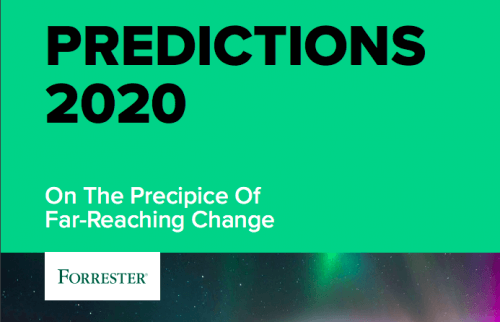Anxiety is ramping up for senior leaders focused on customer experience, and it’s not difficult to understand why.

Image credit: Forrester
So what’s a fearless CX champion like you to do? It’s time to build some bridges.
Your mission, if you choose to accept it, is to begin at the beginning, build your case, and create a coalition of customer-focused leaders.
Your leadership team and executives probably understand that it’s not acceptable to simply skip investing in sales, marketing or customer service.
There’s an understanding that while we make predictions about Return on Investment (ROI), we can’t always guarantee those returns.
Even if that advertising campaign didn’t generate quite as many leads as we wanted, we still invest in marketing strategy the following year. When sales numbers aren’t reached, there may be some adjustments, but we don’t announce that sales is a waste of time.
That’s because there’s an understanding of the cost of NOT investing in these areas.
CX should not be seen as a cost center. And the first thing to do is to understand what’s at risk without strategic investments.
Look for ways to connect those dots first. That’s the risk you take if you don’t invest. That’s the cost of not considering customer experience in a full and integrated way with the strategy of your organization.
Related: Don’t Accidentally Sabotage Customer Experience – Do This Instead
How will you measure success? If Net Promoter Score (NPS) is your metric, then get to know where you stand and where you’ve been.
Just starting out? That’s ok, but you need to get to a baseline understanding of how your success will be measured.
Of course, it’s not just one metric. It’s a combination of metrics, measurements and moments.
Start by painting the picture of where you want to go. Then ensure you understand today’s reality with the right baseline metrics, along with journey maps, ongoing customer feedback mechanisms, and more.
You have to start somewhere, so be sure you really understand where you’re starting.
Related: How to Improve Customer Service Training with Simple Metrics
Customer experience success only comes with cohesive and consistent efforts from leaders throughout the organization.
How can you partner with your marketing team on a customer-centric initiative? Can you share your baselines, journey maps and specific customer insights with the CIO to help with her digital transformation plans?
Leaders want to lead, so help them do that and they will understand the value that you and your CX focus bring.
Yes, it can feel like you are shouting about customers over and over again.
 But true alliance around customer experience comes from deep understanding. This means sharing the metrics that matter in a regular, compelling and concise way.
But true alliance around customer experience comes from deep understanding. This means sharing the metrics that matter in a regular, compelling and concise way.
Then do it all over again.
Related: Overcome Leadership Bias: 5 Common Types and the #1 Solution
There may be a few leaders who already get it and you don’t need to earn their buy-in. They might even help you share the monthly updates and ask for guidance on how to hire more customer-centric team members.
Reward those executives in some meaningful way.
If there is a company-wide kudos program, lavish them with recognition. Or take them to lunch and listen to their ideas. That is sometimes enough to keep an ambassador engaged.
Build a coalition with these leaders and look for ways to support their top business initiatives with strong customer experience practices.
It’s hard to measure success if it’s not defined.
If you don’t have a clear idea of your Customer Experience Mission, now’s a good time to spend some time defining it. Ask for support and consensus as you paint the picture of what an ideal customer experience should look like.
Related: Is Your Mission Customer-Focused, or an Empty Promise?
Leaders are busy, and they might not spend the time you’d like poring over your latest CRM report or NPS dashboard.

Help them by highlighting one thing on a regular basis. If your reports go out monthly, then whoop it up one month over a milestone like completing a long-awaited experience improvement. Another month, mention not just the fact of a better customer experience metric, but the WHY behind it.
These sound-byte successes can help everyone connect the dots between the actions you are taking around CX and the results the business gains.
Be the kind of leader who brings optimism to other leaders.
While other executives might be battling over their fiefdoms, CX leaders must build the bridges over their moats.
Staying positive about what can happen instead of focusing on what can’t happen is an act of courage in some cultures. It’s way too easy to complain about customers, our lack of data/too much data, the way the other leaders keep information from us/share too much responsibility…you get the idea.
Customer experience is really, at its core, a uniquely positive idea. It’s about putting our faith in people. If we and others work hard to create successful, easy, joyful experiences for our customers, they will repay us with loyalty, increased sales, and even their advocacy.
What a gift! Let’s do our best to be the one who enters the room and helps other leaders see their vital role in this wonderfully positive work.
 Jeannie is an award-winning customer experience expert, international keynote speaker, and sought-after business coach who is trailblazing the movement from “Reactive Customer Service” to “Proactive Customer and Employee Experience.” More than 500,000 people have learned from her CX courses on LinkedIn Learning, and her insights have been featured in Forbes, The Chicago Tribune, The Wall Street Journal and NPR.
Get Jeannie’s insights in your inbox each week by subscribing to The Weekly Win and follow her on LinkedIn, Instagram and YouTube.
Jeannie is an award-winning customer experience expert, international keynote speaker, and sought-after business coach who is trailblazing the movement from “Reactive Customer Service” to “Proactive Customer and Employee Experience.” More than 500,000 people have learned from her CX courses on LinkedIn Learning, and her insights have been featured in Forbes, The Chicago Tribune, The Wall Street Journal and NPR.
Get Jeannie’s insights in your inbox each week by subscribing to The Weekly Win and follow her on LinkedIn, Instagram and YouTube.